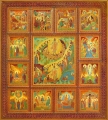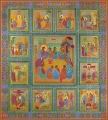|

Christian Holidays
|
|
Holy Trinity (Old Testament)
Artist: Yuri Kuznetsov.
Technique: Tempera, wood panel with raised borders (“kovcheg”).
Size: 75õ100 cm.
Year: 2008.
|
The icon of Holy Trinity by icon painter Yuri Kuznetsov is painted according to the ancient monastic tradition, and it is properly preserved.
"On the day of the Holy Trinity Church prays to God of Three Hypostases to grant us all with the Spirit of grace and compassion and to extend His mercy to all our needs – physical and spiritual, earthly and heavenly, temporal and eternal, extending them not only for the living ones but also for the dead."(Dictionary of Orthodoxy. Dar, 2007). |
| |
| |
|
|
|
|
ALL Christian Holidays |
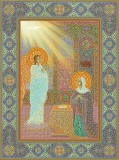
|
|
The Annunciation
The icon “The Annunciation” by Yuriy Kuznetsov was painted according to the ancient monastery traditions, it is well preserved. The icon was exhibited at the expositions, devoted to the Spiritual Renaissance of the modern art.
Before the icon “The Annunciation” you pray Our Lady for relief and recovery from ailments and liberation from restraint.
|

|
|
Ascension of the Lord
The Ascension of the Lord is one of the twelve Christian festivals established after the memory of the Savior’s Ascension. The Festival is related to the Easter Cycle and celebrated on the fortieth day after Resurrection of Christ (Easter). The Festival of the “Ascension of Christ” is an introduction and preparation for the Festivities related to Descent of the Holy Spirit, to the day of Trinity.
|

|
|
Ascension of the Lord
The Ascension of the Lord is one of the twelve Christian festivals established after the memory of the Savior’s Ascension. The Festival is related to the Easter Cycle and celebrated on the fortieth day after Resurrection of Christ (Easter). The Festival of the “Ascension of Christ” is an introduction and preparation for the Festivities related to Descent of the Holy Spirit, to the day of Trinity.
|
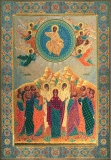
|
|
Ascension of the Lord
The Ascension of the Lord is one of the twelve Christian festivals established after the memory of the Savior’s Ascension. The Festival is related to the Easter Cycle and celebrated on the fortieth day after Resurrection of Christ (Easter). The Festival of the “Ascension of Christ” is an introduction and preparation for the Festivities related to Descent of the Holy Spirit, to the day of Trinity.
|
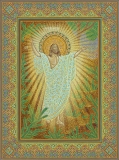
|
|
Resurrection of Christ
The Resurrection of Jesus Christ is the central event of Christian faith, its cornerstone. If not for the Resurrection of Christ not only Christianity would not have existed, but faith in God, in the power of good and truth, would probably have been undermined, the very sense of life of the Orthodox Christian would have been lost. The Luminous Resurrection of Christ, the Easter is the most ancient Christian festival, the most important in the liturgical year – the “Festival of Festivals” and the “Jubilance of All” as sung in the Eastern Canon.
|
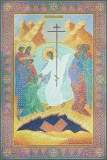
|
|
Resurrection of Christ
The Resurrection of Jesus Christ is the central event of Christian faith, its cornerstone. If not for the Resurrection of Christ not only Christianity would not have existed, but faith in God, in the power of good and truth, would probably have been undermined, the very sense of life of the Orthodox Christian would have been lost. The Luminous Resurrection of Christ, the Easter is the most ancient Christian festival, the most important in the liturgical year – the “Festival of Festivals” and the “Jubilance of All” as sung in the Eastern Canon.
|

|
|
Jesus in White Clothes
The “Jesus in White Clothes” icon is a copy of a 20th century icon painted by the metropolitan Seraphim.
Celebrating the Transfiguration of the Lord the Church solemnly confesses and glorifies the union of the divine and human in the person of Jesus Christ. In Russian tradition the Transfiguration of the Lord God and our Savior Jesus Christ is also called the Apple Savior or the Second Savior.
|

|
|
Jesus in White Clothes
The “Jesus in White Clothes” icon is a copy of a 20th century icon painted by the metropolitan Seraphim.
Celebrating the Transfiguration of the Lord the Church solemnly confesses and glorifies the union of the divine and human in the person of Jesus Christ. In Russian tradition the Transfiguration of the Lord God and our Savior Jesus Christ is also called the Apple Savior or the Second Savior.
|
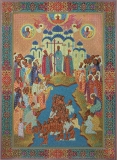
|
|
The Baptism of Russia
In 988 the priests, who came to Rus from Byzantium, baptized the inhabitants of Kiev and nearby lands directly in the Dnieper. Prince Vladimir tried very hard to educate his subjects, although it was long before the ancient pagan customs and superstitions were forgotten. He ordered to acquaint all people with the book literacy and to send their children without fail to study. Divine service was performed in plain language which Slavic people understood and due to this the temples became the colleges of faith and Christianity was quite rapidly and peacefully spread throughout Russia.
|
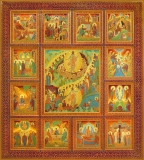
|
|
The Multi-Image Icon
Images of different topics are gathered together on this icon, therefore it is called multi-image. Different events from the lives of the Savior Jesus Christ and the Most Holy Theotokos as well as the themes of great Church festivals are portrayed here. We can see on this icon – the Resurrection of Christ, Descent into hell, Erection of the True Cross of the Lord, Ascension of Christ, Christ’s Entry to Jerusalem, Transfiguration, Baptism of Christ, Holy Trinity, Presentation, Dormition of the Holy Theotokos, Annunciation, Introduction of the Theotokos to the Temple, Christmas, Birth of the Theotokos.
|
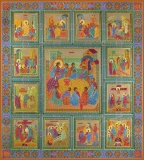
|
|
The Multi-Image Icon
Images of different topics are gathered here, that is why it is called multi-image. The Passion of Christ is intertwined with great Church festivals. This icon portrays: the Lord’s Supper, Mid-Pentecost of our Lord Jesus Christ, Bread Giving, Wine Giving to the Apostles, Lazarus Resurrection, Bringing to Pilate, Crucifixion, Descent of the Holy Spirit on the Apostles, Doubting of Thomas, Myrrh-Bearing Women at the Holy Sepulchre, Deposition from the Cross, Road to Calvary, Foot Washing.
|
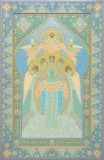
|
|
Icon of the Mother of God of Pskov "the Protection"
The Feast of the Most Holy Mother Protection was established in memory of the miraculous theophany of the Holy Mother in Vlahern Cathedral during Constantinople siege in 910. The Most Holy Mother Protection is a sign of God’s grace, protecting and covering us. The procession to the Heaven, to the Savior is depicted on the icon. The procession is headed by the Holy Virgin, who carries a blanket in her hands, and saints follow Her. The icon symbolizes prayer of the whole Heaven Church for the human being.
|
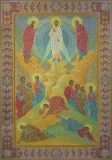
|
|
Transfiguration of the Lord
In order to support faith in His disciples shortly before His passion Jesus Christ showed them His divine glory: “… And was transfigured before them: and his face did shine as the sun, and his raiment was white as the light”. (Mt. 17:1-13; Mk. 9:2-13; Lk. 9: 28-36) The Savior’s Transfiguration is a prototype of people in the Kingdom of God, a future transfiguration of the whole earthly world.
|

|
|
Transfiguration of the Lord
In order to support faith in His disciples shortly before His passion Jesus Christ showed them His divine glory: “… And was transfigured before them: and his face did shine as the sun, and his raiment was white as the light”. (Mt. 17:1-13; Mk. 9:2-13; Lk. 9: 28-36) The Savior’s Transfiguration is a prototype of people in the Kingdom of God, a future transfiguration of the whole earthly world.
|
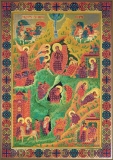
|
|
Nativity of Christ
The Saviour was born on this night, eight days later He would be named Jesus, as had been indicated by the Lord through an angel. The angel appeared in front of the Bethlehem shepherds and said to them: "I announce a great joy to you which will be not only for you but for all people: today in the city of David a Saviour has been born to you, who is Christ the Lord. And here is the sign: you shall find a baby wrapped in swaddling clothes, lying in a manger."
|
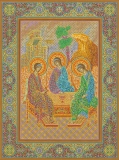
|
|
Holy Trinity (Old Testament)
The icon of Holy Trinity by icon painter Yuri Kuznetsov is painted according to the ancient monastic tradition, and it is properly preserved.
"On the day of the Holy Trinity Church prays to God of Three Hypostases to grant us all with the Spirit of grace and compassion and to extend His mercy to all our needs – physical and spiritual, earthly and heavenly, temporal and eternal, extending them not only for the living ones but also for the dead."(Dictionary of Orthodoxy. Dar, 2007).
|
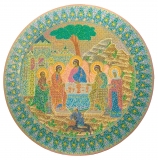
|
|
Holy Trinity (Old Testament)
The icon of Holy Trinity by icon painter Yuri Kuznetsov is painted according to the ancient monastic tradition, and it is properly preserved.
"On the day of the Holy Trinity Church prays to God of Three Hypostases to grant us all with the Spirit of grace and compassion and to extend His mercy to all our needs – physical and spiritual, earthly and heavenly, temporal and eternal, extending them not only for the living ones but also for the dead."(Dictionary of Orthodoxy. Dar, 2007).
|
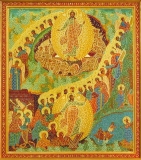
|
|
Resurrection. Descent into Hell
The descent into hell completes the expiatory mission of Jesus Christ. While the body of Christ was in the tomb His human soul descended to the depths of hell and preached to the souls of the deceased thereby setting them free. The Savior led the souls of Old Testament righteous people out including Adam and Eve. There is almost no mention in the canonical Gospels about the descent of Jesus Christ to hell. This event is described in much more detail in the apocryphal “Gospel according to Nicodemus.”
|
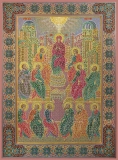
|
|
Pentecost
In the Orthodox Church the Holy Trinity is glorified mainly on the first day of Pentecost – Sunday, which is called Pentecost day. Liturgy of this day reveals the dogmatic teaching of the Holy Trinity, and the Icon with its image is brought out on that day for worship. As to Icon of the Descent of the Holy Spirit upon the Apostles it is brought out on Monday, the second day of Pentecost which is dedicated to the Holy Spirit and is called the day of the Spirit. Thus, the two icons correspond to the feast of Pentecost.
|
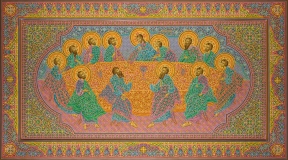
|
|
The Holy Supper
After eating the Old Testament Jewish Passover Jesus Christ instituted at this supper the Sacrament of Holy Communion. Therefore it is called “The Holy Supper”. The Savior gave His disciples under the likeness of bread and wine the same Body and the same Blood that he would give for suffering and death for our sins the next day. The Lord gave commandment to always administer this sacrament, saying: “Do this in remembrance of me.” (Mt. 26:17-35; Mk. 14:12-31; Lk. 22:7-39; Jn. 13-18)
|
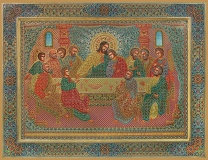
|
|
The Holy Supper
After eating the Old Testament Jewish Passover Jesus Christ instituted at this supper the Sacrament of Holy Communion. Therefore it is called “The Holy Supper”. The Savior gave His disciples under the likeness of bread and wine the same Body and the same Blood that he would give for suffering and death for our sins the next day. The Lord gave commandment to always administer this sacrament, saying: “Do this in remembrance of me.” (Mt. 26:17-35; Mk. 14:12-31; Lk. 22:7-39; Jn. 13-18)
|
| To go back into beginning |
|
|
|

